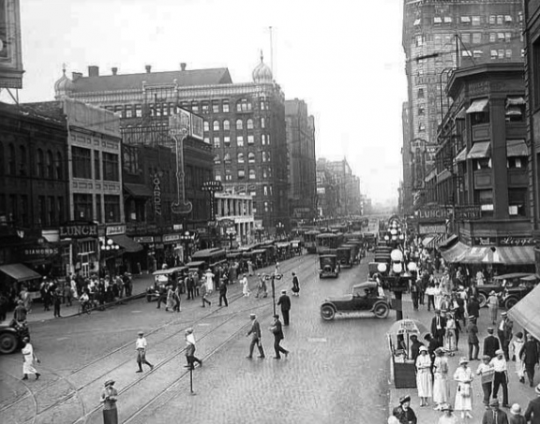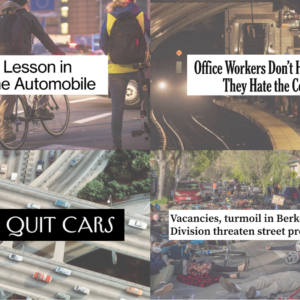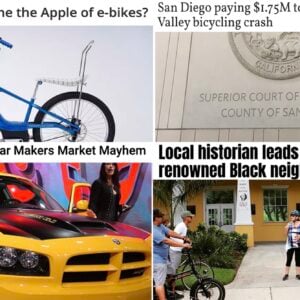Here are the great bike links that caught our eyes this week:
“A hundred years ago it was called Safety First”: Streetsblog’s two–part interview about Vision Zero with traffic historian Peter Norton is a must-read. The campaign for safe streets can learn a lot from the century-old campaign to make them unsafe.
“Customer code of conduct”: A bike shop in southern California is making all customers who wear their team uniform commit to obeying traffic laws.
Onshoring bikes: The Wall Street Journal takes a close look at the new factory in South Carolina that, with wages of $12 an hour, expects to produce $120 Walmart bikes more cheaply than China can by 2017. (Click the first link on the search page.)
Prescience requirement: Washington DC is considering getting rid of its unusual law that shields drivers from liability in situations where a person on a bike failed to anticipate the driver’s illegal actions.
Passing distance research: Painted bike lanes don’t actually have much effect on car-bike passing distance compared to factors like other cars and, maybe, the driver’s attitude.
Misperceiving risk: Seattle’s Sightline Institute made a useful chart of the relative danger of two frightening epidemics:

Sex with cars: “Masturbation is, I guess the word” for what this Tacoma-area man has done with 700 cars since 1965. He identifies as a mechanaphile.
Anti-bike trolls: You probably have to leave BikePortland to play bike news commenter Bingo.
Advertisement
Money walks: It’s hard to see a strong pattern in the places people die while walking, but if you also map injuries an overwhelming trend emerges: places poor people live.
Vive la différence: It’d be nuts for the law to treat bikes and cars identically, an Alexandria Times contributor argues.
Debunking congestion: New website City Observatory has a great takedown of a new report that parrots the “cost of congestion” myth that wider roads would help the economy.
Safety conference: Four years after the “Vision Zero” concept started circulating in the bike world, the country’s brains are gathering in New York City next month for a national symposium on the subject.
Parking shortage: According to the BBC, bike parking space is so scarce in Copenhagen that most people just leave their bikes in huge piles — what are the odds their bike will be the one stolen?
Suburban bike sharing: Capital Bikeshare is expanding rapidly in Arlington, Virginia, though rising ridership hasn’t made it operationally profitable.
Rolling park: A Brussels art collective has created a modular cargo bike that is also a “temporary park,” transforming into a mobile cinema or a waffle cart.
Bike manufacturing: Michigan has quantified its growing bike industry: $668 million a year, with the largest single hub of it in Grand Rapids.
In your video of the week, our friends at The Path Less Pedaled check out one of Oregon’s most unique cycling experiences: rocketing in custom 4-wheelers down an otherwise abandoned rail line in Joseph.
If you come across a noteworthy bicycle story, send it in via email, Tweet @bikeportland, or whatever else and we’ll consider adding it to next Monday’s roundup.
Correction 10/21: An earlier version of this post misstated the site of the rail pedaling service.






My favorite item was missing from bicycle journalism bingo: “in fact, Bogota began ciclovias over thirty years ago. “.
Why are the fatality numbers tracked to two decimal places?
Because some of those people are only mostly dead.
Onshoring bikes: please don’t link to wsj.com articles because they require a paid subscription to view…
Copy the article title into google and itll be the first result, free to read.
interesting… same exact link, but clicking through google lets you read it…
Its like that on purpose. Same deal if you click into from facebook.
Or a Multnomah County Library card. The library offers WSJ (as well as many other papers) online under the research tab (might take a little searching to find it from there).
The prescience link is to the Code of Conduct article.
and Debunking congestion links to the passing distance article…
Thanks Spiffy. Fixed it.
Thanks. Fixed it.
Not bike news exactly, but this data analysis shows that the biggest predictor of traffic related injuries is vehicle miles traveled. And then when you control for VMT, one thing that more-than-expectedly dangerous places have in common, is Googling for pickup trucks. http://www.psmag.com/navigation/health-and-behavior/1-cause-traffic-fatalities-texting-92121/
And pickups correlate strongly with rural driving, which is known to be the most dangerous. High speeds, blind corners, un-signalized intersections, drinking, etc.
If you look at the stats, Wyoming has a fatality rate that is something like 9x the per-capita rate in Washington D.C. D.C. is on par with the best European countries, and Wyoming is on par with developing countries in Asia and Africa.
While you might be on to something with pickups, It should be pointed out that Wyoming also has horrible weather, probably the sparsest population in the US (further towns means more driving), and a very low population overall. All these factors are likely skewing the data more so that pick up trucks specifically.
From the “Applying the same rules to cyclists as motorists is nonsensical and dangerous” piece:
As a motorist, nothing irks me more than being behind a cyclist who is turning left.
Pure car head.
One of the attractions of cycling as a transportation mode is the ability to function as a vehicle or pedestrian in a fluid and context-specific manner. If the author truly finds “being behind a cyclist” irksome he should use a different route with fewer cyclists or simply stop driving.
I do, however, agree with the premise that vehicular cycling is absurd. I almost never cycle in a vehicular fashion — even when riding in the lane.
I didn’t really see any examples in this article of suggestion for how the legal treatment of motor vehicles and bikes should differ. The author kind of seems to say that cyclists should be able to do whatever they need to do to stay out of the way, even if it isn’t strictly legal (like sidewalk riding).
I’d be plenty happy if cyclists were just given equal respect by the legal system, regardless of laws. But, for the sake of staying on topic, here would be my suggestions for Oregon:
1. Repeal ORS 814.420
2. Adopt so-called “Idaho Stop” law—including the ability to treat red lights as STOP signs
3. Limit application of “impeding traffic” principles when bikes are involved. One law I’ve read about lately (can’t remember which state has it) essentially states that if a vehicle is moving at or near its top speed, it cannot be considered to be impeding traffic. Also, when there are multiple bikes and one car on the road at a particular place and time, the “prevailing speed of traffic” needs to be re-thunk.
So essentially, I’d like laws and law enforcement to stop using intimidation to try to keep cyclists “in line”.
“The author kind of seems to say that cyclists should be able to do whatever they need to do to stay out of the way, even if it isn’t strictly legal (like sidewalk riding).”
I believe cyclists should take advantage of the things a bike can do without being overly concerned about staying out of the way. Some examples: using sidewalks/crosswalks opportunistically and treating every intersection as a potential advanced stop line.
“I didn’t really see any examples in this article of suggestion for how the legal treatment of motor vehicles and bikes should differ.”
The author argued for crossing “the street when traffic [either] abates”. I agree with this and would argue that “jaybiking” is almost as common as jaywalking in PDX. Moreover, in OR it’s also legal (or not illegal) to pass in lane, ride two abreast, not signal turns, filter, split lanes, ride on the sidewalk/MUPs etc. Given such clear differences in the law and in ubiquitous cyclist behavior I just don’t see bikes as “vehicles”.
“I just don’t see bikes as “vehicles”.”
they’re more like roller skates… but I think roller skates are also considered vehicles…
“roller skates are also considered vehicles”
Only in PDX. I’m still not a fan of using laws/definitions designed for and by motorists to give active transport “rights”.
Bikes have as much in common with pedestrians as they do with cars.
“…crossing “the street when traffic [either] abates’”
Ah. I saw this quote differently, I think. I did not take this as advocating something like treating a stop light as a stop sign, I took it to mean that at an unsignalized intersection, he would wait for traffic to abate, while at a signalized intersection, he would wait to “have” the light. I saw this whole quote as merely advocating for pedestrian (a.k.a. “Copenhagen”) left turns. Myself, I’d rather wait for half as many lanes of traffic to “abate”; plus, drivers have a much easier time passing me on the right than they would another car waiting to make a left.
I agree with most of the rest of your statement, that bicycle users should have the freedom to responsibly exercise the capabilities of their vehicle, without being compelled to operate in an unsafe or unfairly inconvenient way. By “unfairly” inconvenient, I mean that if a driver doesn’t have to put up with an equivalent inconvenience, than neither should a cyclist; e.g., pedestrian left turns, using “beg buttons” and sidewalks, etc. I’d like to see bike lanes treated as bike refuge lanes, where a cyclist can retreat to allow traffic to pass—or pass stopped car traffic—but not a compulsory detention zone (sometimes referred to as “nowhere”, as in, “he came out of nowhere!”).
As users of a small, lightweight, nimble vehicle, bicyclists have a number of capabilities that they may use—sometimes to grant motorists free passage, sometimes to their own advantage in getting around motor traffic—but they should be allowed to use these capabilities at their own discretion, not forced to because of misguided laws.
It’s awesome to see a fleet of rail bikes. They (and autovelos) have been a fantasy of mine since I was just a small boy in a town of similar size. Getting arrested for trespassing probably would have been the luckiest outcome of doing that for very long, considering the active status and condition of tracks around there.
I’m not likely to just leave my bike in a pile. I’ve spent several years and iterations for it to take that personal shape. Groceries or otherwise, it hauls, be it to StormBreaker (on Mississippi) or Thunder Island (Cascade Locks).
We use “same rules” because they’re same roads. The author states: “nothing irks me more than being behind a cyclist who is turning left” and the solution to this first-class nuisance is for all cyclists make the so-called “Copenhagen Left”. I’ve got a “New York Salute” to that idea of taking a back seat to drivers.
Just aw a matter of idle curiosity, why is rail biking so dangerous that everyone in the video is wearing a helmet?
It isn’t. It’s probably got more to do with insurance companies and possible litigation than any type of real risk.
That piece by Shane Farthing on the antiquated DC law of contributory negligence was a really excellent takedown. What struck me immediately, besides the ludicrous nature of that statute, was that wsbob and El Biciclero and I have been arguing about some of the elements of the screwed up situations he writes about here for years, but without the lawyerly jargon or his knowledge of the laws that make it so frustrating.
Thanks for linking to that article, bikeportland. Wow.
Informative article. Not sure, but I presume Oregon is one of the 45 states that uses a comparative fault system, rather than contributory negligence, to aid in determining responsibility for the consequences of collisions.
The contributory negligence system The DC courts are obliged to make their judgment by, as explained with examples of collisions, writer Farthing cites, didn’t treat the injured parties justly, I don’t think.
People that ride, do have responsibilities as road users, to guard against danger to their own safety and that of others on the road. Their making mistakes that contribute to collisions they’re involved in, should not though, automatically relieve the other party involved in a collision, from mistakes they also have made that contributed to the collision.
Yes, good link and frightening legal environment they got there in D.C. Yikes!
The rail rider video was near Joseph Oregon – not LaGrande.
Thank you, Roger – fixed.
Yep, hicks in the sticks will drive with their dicks.
The fact that bike lanes have a negative effect on passing distance is actually written into Oregon law. From ORS 811.065, “Unsafe passing of person operating bicycle” (emphasis mine):
“The driver of a motor vehicle may only pass a person operating a bicycle by driving to the left of the bicycle at a safe distance….This paragraph does not apply to a driver operating a motor vehicle…[i]n a lane that is separate from and adjacent to a designated bicycle lane.”
There is no mention of the position of any potential bicyclist that might be present, so strictly according to the text of this law, even if a bicyclist is legally operating near the edge or even outside of the bike lane, a motorist has NO legal obligation to pass at a safe distance. The mere presence of a bike lane absolves drivers of all safe passing consideration. The exception above could have been written to the effect of “…does not apply to a driver operating a motor vehicle [while passing a bicyclist who is operating completely within an adjacent bicycle lane]”. This wording would have shielded bicyclists from the interpretation that if they dared to leave the bike lane—even for legitimate reasons—they deserved to get buzzed or run over. The other glaring omission to this law is that the only “prima facie” evidence of unsafe passing is hitting a bicyclist in a no-passing zone. If I imagine a scenario where a bicyclist was operating at the edge of a bike lane to avoid storm drains or doors, or had left the bike lane to “prepare for a left turn”, a speeding driver could rear-end or sideswipe such a cyclist with absolute impunity. My episode of “Perry Mason” goes like this:
“But he ran over me, while speeding, and I was clearly visible!”
“Well, you should have stayed in the bike lane.”
“I was in the bike lane!”
“Well, your elbow was hanging over the line; you must have swerved.”
“I didn’t swerve; the bike lane was next to parked cars and I was avoiding doors!”
“Was there an open car door that you were avoiding?”
“No, but I have to assume that any door could open at any time!”
“Regardless of why you were outside the bike lane—”
“But I wasn’t outside—”
“You were outside the bike lane or you wouldn’t have been hit. Drivers have no obligation to allow any passing distance when a bike lane is present.”
“What about when an actual person is present?”
“The law does not address that.”
Anyway, I’d love to hear a real legal interpretation of this statute and how it relates to safe passing requirements.